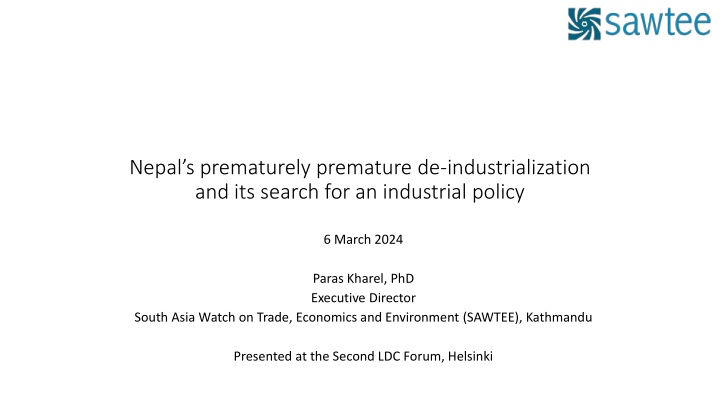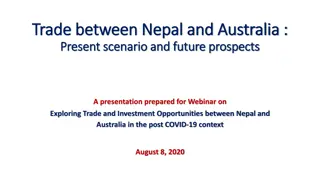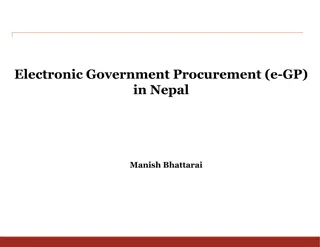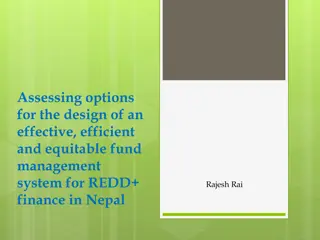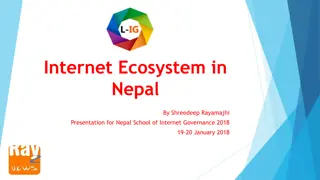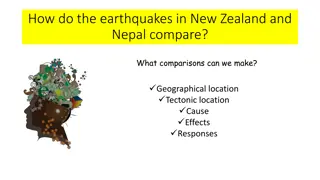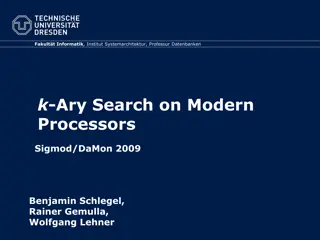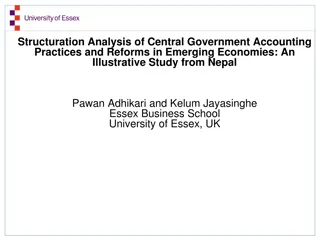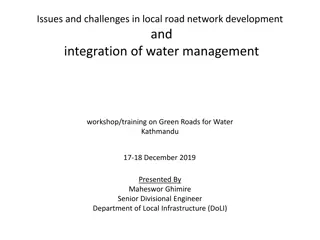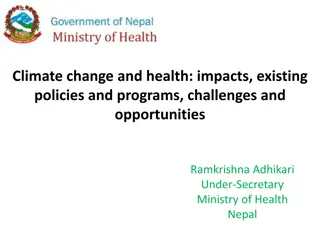Nepal's Industrial Challenges and Search for Policy
Nepal faces de-industrialization, with a low share of manufacturing employment and value added. This leads to a weak structural transformation and a heavy reliance on remittances. The country seeks an industrial policy to drive economic growth and address these challenges.
Download Presentation

Please find below an Image/Link to download the presentation.
The content on the website is provided AS IS for your information and personal use only. It may not be sold, licensed, or shared on other websites without obtaining consent from the author.If you encounter any issues during the download, it is possible that the publisher has removed the file from their server.
You are allowed to download the files provided on this website for personal or commercial use, subject to the condition that they are used lawfully. All files are the property of their respective owners.
The content on the website is provided AS IS for your information and personal use only. It may not be sold, licensed, or shared on other websites without obtaining consent from the author.
E N D
Presentation Transcript
Nepals prematurely premature de-industrialization and its search for an industrial policy 6 March 2024 Paras Kharel, PhD Executive Director South Asia Watch on Trade, Economics and Environment (SAWTEE), Kathmandu Presented at the Second LDC Forum, Helsinki
Nepal is 58% of its way through demographic window of opportunity Source: National Planning Commission, 2017
Missing industry? A. Sectoral shares of value added B. Sectoral shares of employment 70 80 76 74 70 57 60 63 53 50 60 50 50 40 34 40 % % 32 30 27 30 21 20 16 15 15 20 16 15 14 11 10 10 10 0 0 Agriculture Industry Services Agriculture Industry Services 1998 2008 2018 1998 2008 2018 Source: Panel A: Author computation using WDI data; Panel B: Bulmer, Shrestha, and Marshalian (2020) using National labor Force Survey (NLFS) 1998, 2008, and 2018 data
Manufacturing share of employment is low and has barely changed 10 Manufacturing share of employment (%) 9 8 6.8 7 6.6 5.8 6 5 4 3 2 1 1998 2008 2018 Year Source: NLFS 1998 and NLFS 2008; Bulmer, Shrestha, and Marshalian (2020) for 2018
De-industrialization, weak structural transformation Manufacturing value added, % of GDP Per capita value-added growth driven by static reallocation and demographic change 10 9 8 7 6 5 % 4 3 2 1 0 1990 1991 1992 1993 1994 1995 1996 1997 1998 1999 2000 2001 2002 2003 2004 2005 2006 2007 2008 2009 2010 2011 2012 2013 2014 2015 2016 2017 2018 2019 Bulmer, Shrestha, and Marshalian (2020) World Development Indicators
Nepals comparative export performance Nepal s comparative manufacturing performance Source: WDI, World Bank
Remittances dwarf other external inflows 10,000 9,000 8,000 7,000 6,000 US$ million 5,000 4,000 3,000 2,000 1,000 - (1,000) 2000 2001 2002 2003 2004 2005 2006 2007 2008 2009 2010 2011 2012 2013 2014 2015 2016 2017 2018 2019 2020 2021 2022 Personal remittances, received (current US$ million) Exports of goods and services (current US$ million) Net official development assistance received (current US$ million) Foreign direct investment, net inflows (BoP, current US$ million) World Development Indicators
World Bank High input tariffs reduce efficiency of firms High final goods tariffs and high ERP misallocate resources into protected sectors Creation of anti-export bias Suggests liberalization, with tax revenue loss of 4-8% A staple in private sector s demands before the annual budget At least # slab difference in tariffs on imports of raw materials/intermediate goods and final goods Government concerned about revenue loss Revenue advisory committee s report Infant industry: Unresolved debate Effective rate of protection World Bank, 2021, Fiscal space for sustainable development: Nepal public expenditure review
Way forward Industrial policy as something more than the formal Industrial Policy", a regime A study on the import duty structure in terms of its ability to serve the government's goals of industrialization, export expansion, revenue generation. Such a study should inform an industrial development strategy While Nepal has a trade integration strategy, it lacks an industrial development strategy Anchored in the Nepali milieu of massive outmigration and remittance inflows A production transformation policy review, which draws on the entire spectrum of evidences and thoughts in the development literature, could be useful Updating policymakers on emerging evidence on the subtleties of industrial policy Trade adjustment fund to help workers and firms that will be hurt by trade liberalization Contributions as aid for trade from development agencies, especially those that advocate tariff liberalization/ rationalization
Thank you Paras.Kharel@sawtee.org
